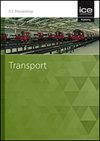An Evaluation of Emergency Vehicle Preferential Treatment Strategies by Traffic Simulation
IF 1
4区 工程技术
Q4 ENGINEERING, CIVIL
Proceedings of the Institution of Civil Engineers-Transport
Pub Date : 2022-05-03
DOI:10.1680/jtran.22.00019
引用次数: 1
Abstract
Emergency vehicles (EVs) must reach their destination within the shortest amount of time considering the importance of their service in saving lives and reducing property damage. This research aimed to reduce the delay experienced by these vehicles through the alteration of traffic control signals that would give preferential treatment to EVs upon detection. Specifically, this study compared three algorithms with concepts of emergency vehicle pre-emption (EVP), longest queue first, and emergency vehicle signal priority (EVSP) based on average general and EV delays through traffic simulation approach via VISSIM and its component object model (COM) interface. The performance evaluation was applied in Tuk Chai Intersection in Bangkok, Thailand as a case study. It was found that the second algorithm of longest queue first with pre-emption is the best approach for both 0.8 (peak) and peak hour traffic conditions, performing better than the do-nothing condition by 69.70% for stochastic EV input and 79.14% for fixed EV input. The findings of the study also show that the algorithm of preferential treatment using EVSP strategies produced a competitive and robust performance that has EV delay values being better than the do-nothing condition by 75.96%, 77.27%, and 45.67% in 0.8 (peak), peak-hour, and 1.2 (peak) traffic conditions, respectively.基于交通仿真的应急车辆优先处理策略评价
考虑到应急车辆在拯救生命和减少财产损失方面的重要性,它们必须在最短的时间内到达目的地。本研究旨在通过改变交通控制信号,在检测到电动汽车时给予优先处理,从而减少这些车辆的延误。具体而言,本研究通过VISSIM及其组件对象模型(COM)接口的交通仿真方法,比较了三种基于平均一般和EV延迟的应急车辆抢占(EVP)、最长队列优先(longest queue first)和应急车辆信号优先(EVSP)概念的算法。并以泰国曼谷德斋十字路口为例进行了性能评价。研究发现,无论在0.8(高峰)交通条件下还是在高峰时段交通条件下,具有抢占优势的最长队列优先算法都是最优算法,在随机EV输入下比不行动交通条件下的效率提高69.70%,在固定EV输入下比不行动交通条件下的效率提高79.14%。研究结果还表明,采用EVSP策略的优先处理算法在0.8(高峰)、高峰小时和1.2(高峰)交通条件下,EV延迟值分别比不做条件好75.96%、77.27%和45.67%,具有较强的竞争力和鲁棒性。
本文章由计算机程序翻译,如有差异,请以英文原文为准。
求助全文
约1分钟内获得全文
求助全文
来源期刊
CiteScore
2.60
自引率
0.00%
发文量
42
审稿时长
5 months
期刊介绍:
Transport is essential reading for those needing information on civil engineering developments across all areas of transport. This journal covers all aspects of planning, design, construction, maintenance and project management for the movement of goods and people.
Specific topics covered include: transport planning and policy, construction of infrastructure projects, traffic management, airports and highway pavement maintenance and performance and the economic and environmental aspects of urban and inter-urban transportation systems.

 求助内容:
求助内容: 应助结果提醒方式:
应助结果提醒方式:


